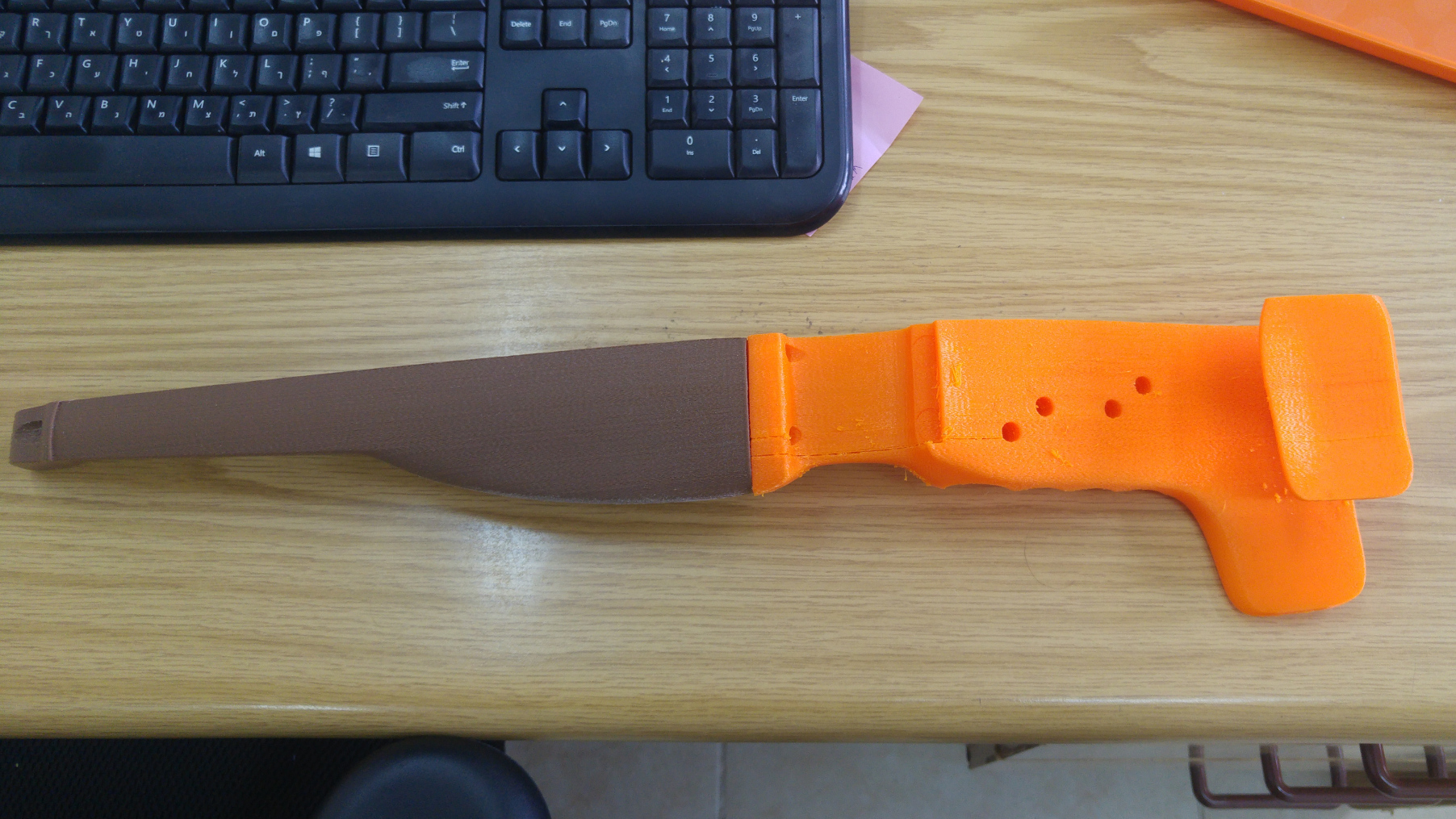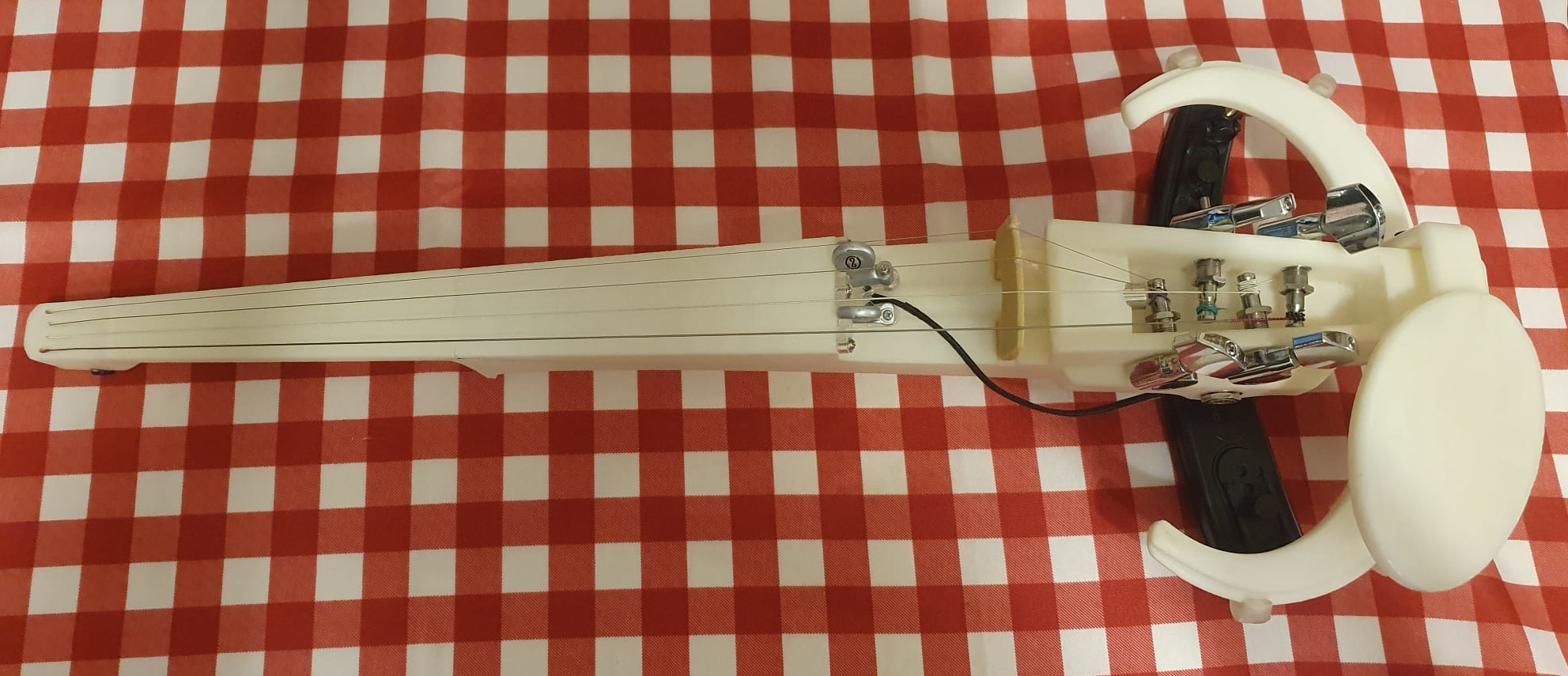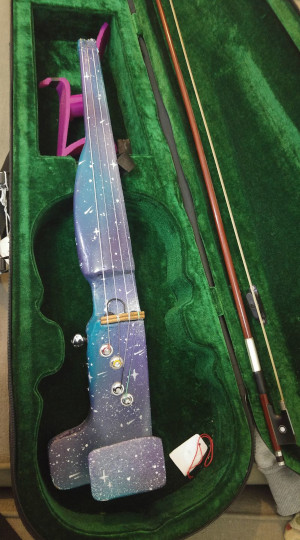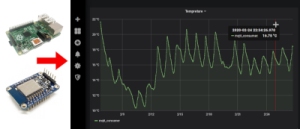Truss violin – I deigned, 3D printed and built a violin and I am releasing it open source August 18, 2023
Posted by GuySoft in open source, violin.Tags: 3D Printers, open electroncs, open source, violin
add a comment
Hey all,
In the past years I have had an ongoing project – I wanted an ultra-light modifiable electric violin. And finally I can share it with you.
This violin, weighs with all the parts on just 500 grams, which is the same as my acoustic violin. Moreover, the center of mass is close to the player making the violin feel lighter than an acoustic when playing.
This is made possible by an innovation I came up with, and have not seen anyone else do – The violin uses a truss like the one in a guitar neck, letting you balance the weight of the strings and tune the neck. This means that the violin can be printed with just a 15% infill making it ultra light (pegboard box at 20%).
I am not planning to start a violin-building business, so I see no reason to keep this to myself and I am releasing it. I ask you to give me some attribution, and consider releasing your design too. And perhaps a violin 🙂
This is the end result
The design
I made the design with the help of several mechanical engineers that I want to thank – Tal Reindel, Michael Lev-Ari Layoush, Itai Meshorer, and Don Corson. Also want to take the opportunity to thank Yair Grinberg, Oleh Shevchuk. It’s also based on the ElVioin v2 which is under the Creative Commons – Attribution – Share Alike license. So you can use it, share it, modify it and even sell it. But our particular design must also be released under the same license.
You can download the design files here.
(more…)Fedigroup – group system for the Fediverse August 7, 2023
Posted by GuySoft in open source, programming, python.Tags: fediverse, open source, programming, python
add a comment
Hey all,
The past year I’ve been playing pretty active on federated social networks. This led me to try and write a federated social network group system. Although this group system is far from being complete since Fedigroup is currently in pre-alpha level. I think it is worth sharing what I have learned, and also explain a bit why, if you met me during the past three years. I’ve been going about federated social networks.
You are also welcome to join a server I maintain here, Hayu.sh is the second largest Hebrew-speaking instance.
What is a federated social network?
A federation in servers means everyone can run their own server which is autonomous. And it can communicate with other servers too. Creating a large network. The first protocol on the internet is actually federated too – email.
There is no one central email server, or single email software. In social networks this means that you join a server, and follow and interact with everyone else. Even though your server could be, like in my case, hosted in your own home, with you owning all the data. You can also join a any other server, and switch between them.
For Hebrew speakers, I gave a small TED lecture about it, which is hosted on a federated video server. You can watch it here (Hebrew).
The Fediverse is the servers using the a W3C Standard that does just that
What made the Fediverse possible is the standard that was passed to describe it. The protocol is called ActivityPub 2.0. And it lets social networks share status messages (notes), shares (boosts) and favorites across different servers. It was created by a group of people who cared, not large companies. Despite some of them being members of the W3C. Its also worth mentioning that one of the major adopters of the ActivityPub 2.0 protocol was Mastodon, a type of social network server, which resembles twitter. And that really help gain critical mass.
Why didn’t I hear about this?
I was asked this by other developers and power users. It makes people dismiss the Fediverse as a passing or niche thing.
Unlike Facebook, Twitter even if you’re been avoiding social networks, their marketing will reach you, your news channel, municipality and country are likely using them. Their existence depends on it that you use and browse on their site. However, in the Fediverse does not have a business model that demands it. Or a marketing team. Its just people. You are welcome to join, but no ones income depends on it.
The Fediverse is growing though, by word-of-mouth, or text-in-blog. Recently even celebrities and others. The latest are the BBC, PNAS, George Takei, Neil Gaiman, Stephen Fry and the European Commission.
(more…)Back in 2018 – I made my first electric violin, and an FX system (repost from violinmakers) June 26, 2023
Posted by GuySoft in open source, violin.add a comment
Hey all,
Back in 2018 I wrote a blog post about the electric violin that I built. Life got crazy and it got stuck as a draft. Its a really good iteration process, and soon I plan to release a fully open source design I made which is much better than this one. However, this is the first violin I made and despite the sound being iffy, its by far the prettiest. So here is the post about how I made it. I am also adding notes from today, 5 years later. Since stuff has developed and I am in the process of releasing my own design.
So here is the post:
So I 3D printed an electric violin, I wanted to share with you how I did this, what I learned in the process. And perhaps spark a community to share these violins and knowledge how to build them. Arnon Zamir was a partner and we did a mix of research and building together. Dar Abramov did the amazing paint job.
So there is this wonderful project violin designed by David Perry called the F-F-Fiddle. I think the most innovate part is using a carbon fiber rod (originally aluminum) to connect several parts from a 10inch (254mm) and now 8inch (200mm) 3D printer.
The model
David published a pretty comprehensive PDF with the design and assembly instructions. However I wanted to take it a few steps further and do a cool paint job and finish.
First I used Luke’s bout, it was a bit of the mistake because we actually had to cut the guitar keys so they would fit (and that makes them bend a little). The Guitar keys are at the moment the most annoying thing in the F-F-Fiddle.
We really want to change that.

Pi Imager – community managed fork of rpi-imager March 23, 2022
Posted by GuySoft in open source, programming.Tags: cpp, open source, qt, Raspberry Pi
add a comment
Hey all,
I have started to maintain a fork of rpi-imager called Pi Imager. The main goal of it is to have a place to host images for anyone who wants their images downloaded and flashed with a single tool. There are already 7 extra distributions you can flash on the unofficial imager and I hope with this post this number will grow.
The changes to the official imager are:
- There is an unofficial category that has images you can’t get on the official imager. You can submit a pull request to this repository and add yours.
- Everything is automatic. You can fork it, make your own commits, and you have a working build system –
- Every new commit to pi-imager builds a new build for Windows, Mac and Linux, ready to use
- When you ask to add a new image and the pull request is accepted, it’s added to the global list automatically
- There is a feature to disable username change that can be set on the distribution side. It broke stuff in OctoPi (currently in main branch).
- Appimage support for Linux (fixes this issue)
- Trademark and colors have been removed as requested by RaspberryPi, it’s purple now!
OctoPi-Klipper – OctoKlipperPi – OctoPi that ships pre-configured to work with Klipper November 1, 2021
Posted by GuySoft in Uncategorized.add a comment
Update: OctoPi-Klipper is now called OctoKlipperPi. The reason is that it was too similar and people kept confusing the two.
Hey all,
I recently upgraded my printer’s board to an MKS SGen v1.0 (thanks to Tal Raindel who had one at hand). Not the latest board out there, but newer than my old MKS Gen l 1.0, which decided to die.
This give me the incentive to switch from Marlin 1.0 to Klipper. When I did that, I found that the only way to get Klipper working with OctoPi, is to manually run a bunch of commands on the Pi.
In a way, its been stuck in the same state OctoPrint was in 2013 when no one was using it, I wrote about that then when creating OctoPi.
So this led me to build OctoPi-Klipper, which is basically just OctoPi bundled with the latest OctoPrint and latest Klipper, shipped with the correct settings on OctoPrint.
I also made it ship with OctoKlipper plugin, which lets you paste in the printer configuration for Klipper and a few other improvements.
I used CustoPiZer written by Gina, and derived from CustomPiOS, mainly to help people adopt
Get the latest OctoPi-Klipper images here
Code contributions are welcome!
BackupFriend – Self-hosted backup to your RaspberryPi with a history and UI! July 19, 2021
Posted by GuySoft in open source, programming, python, wxpython.Tags: backupfriend, howto, open source, programming, python, self-hosted
2 comments

Atribution: Icon by: Freepik
Hey all,
I am releasing today something I’ve been working on the past year. It stared with a friend that had a requirement to do off-site backups of his work for his insurance, but BackupFriend has became a full blown backup solution.
The idea is you get a RaspberryPi and plug a harddrive to it, put it at your friends, family or just in your house and backup up to it using a desktop client that should have the feel like Dropbox/Google Drive/etc. You also get history! The RaspberryPi can also be changed to a remote server (instructions here). This guide focuses on self-hosted instructions, because I think its strange all backup solutions out there require you to pay rent for your own data.
Using a 4TB drive for under $100 and a Pi, you can get much more storage which is not ephemeral.
The desktop client has been tested on both Linux, MacOS and Windows.
Also, many thanks to Pull Request Community that featured BackupFriend as a project to work on, that helped get a few PRs on-board.
What you will need
- A Raspberry Pi, preferably 4B because of the USB3
- Note: Raspsberrypi can be replaced with a server (instructions here).
- A home network with a computer running Linux, MacOS or Windows, which you will be backing up from
- An external hard drive that can connect to the Pi (I use a 4TB WD My Passport drive, you can also just use a thumb drive for testing).
How to install on a Pi
(more…)PleromaPi – Run your own distributed social network on RaspberryPi November 5, 2020
Posted by GuySoft in open source, programming, python.Tags: fediverse, pleroma
25 comments
Hey all,
The latest Raspeberry Pi I am releasing is a distro that lets you flash and run social network called Pleroma. Its part of a group federated social networks known as the Fediverse. There are about 4 million users to date, although this does not compare to the giants today, its enough that the software is fairly mature and it looks and feel like networks you know, and there are enough people to follow and get a decent feed to read. It also mean you can use it for different uses not covered by mainsteam social networks.
Requirements
- A domain name that redirects to your Raspsberry Pi – you need a domain name because communication from server-to-server happens on HTTPs, which needs a domain for the signature to work. And laso because usernames are in format @user@server.tld .
- Raspberry Pi prefrebly 3B+ , 4B and above.
- Pi should be connected to internet.
MtigOS – Plotting sensor data from ESP8266, where all of the work has been done for you March 2, 2020
Posted by GuySoft in Android, diy, Electronics, linux.Tags: esp8266, IOT, Raspberry Pi, release
11 comments
Hey all,
This project started from a hackathon, where the organiser dumps a pile of esp8266 chips and sensors on a table that were up for grabs. I wanted build something that would take about 10 seconds to assemble and flash, and would be functional anywhere, no hardcoding of wifi settings and servers. Since I am the developer of CustomPiOS I also made a Raspberry Pi distro that has all the fancy dashboards pre-installed.
This work is also modular and written in a way you could build long lasting solutions, the code is all arranged so it’s easy to contribute and have a monitoring solution which is easy to customize.
What I am going to provide here is a set of tools, that would let you get pretty graphs from sensors with:
- NO coding required
- NO hardcoded wifi passwords or server settings
- NO soldering
- About 2-5 minutes assemble the hardware
- You get a standard which is supported in my dsitro and other devices. So you can use MQTT apps that are out there.
- Raspberry Pi image that sets up all the software that lets you see fancy graphs right away. Calling it MtigOS. It also automatically updates and is maintained.
- You are going to use Docker, without the need to know how to use Docker.
Cool tricks I am going to use:
- You press the reset button a couple of times to enter a web config interface available in an access point so you can set up your wifi and MQTT server
- I am saving you hosting this on a server and giving you the option to host this locally using a Raspberry Pi image.
- docker + docker-compose that sets up a database and graphing tool – everything is already all set up. So if you want a server instead of a Raspberry Pi you can use that too
no need to know docker.
How to build a telegram-controlled sous vide using CraftBeerPiOS October 1, 2018
Posted by GuySoft in Electronics, open source, python.Tags: cooking, food, open source, raspberrypi, telegram
4 comments
Hey all,
So I’ve been cooking sous vide a few months now, with a sous vide I built myself. Its connected to a RaspberryPi and can be controlled via the web or telegram.
No soldering required!
Flash a ready made image to the Pi!
Bill of materials
- Slow cooker (crockpot) with a ‘high’ option. You can get them second hand, they are pretty cheap. Make sure it has no digital control.
- Raspberry Pi, even version 1 should work – also an SD card and power supply for the Pi.
- Pi Plate prototype board. Make sure you get one that matches your Raspberry Pi footprint if you are re-using an old Pi.
- Solid state relay that can handle mains
- Power cables
- Data cable to connect the relay to the Pi
- Power socket and power connector for your country – get locally so it fits your country standard.
- Water resistant temperature sensor DS1820 x2 – Get a spare one so you can measure the temperature difference and make sure your sous vide is uniformly heated.
- Important – 3D printed enclosure for raspberrypi (Raspberry Pi 1) and enclosure for the relay – you are mixing water and electricity in a kitchen, don’t be an idiot.
Assembly
New violin makers community August 27, 2018
Posted by GuySoft in music, open source.Tags: 3D Printers, community, discorse, open source, violin
add a comment
violinmakers.org logo
Hey all,
So I was going to post here about a violin I 3D printed and built, and then realised that this is a community waiting to happen. So I created a discourse forum called violinmakers.org. A place for people to share knowledge on how to build electric violin cellos and anything in between.
Electric violins today are usually heavier than their acoustic counterparts, 3D printing and carbon fibre makes it possible to print lighter violins with complex parts. Instead of spending a lot of time carving them in to heavy wood. The need is growing since nearly all music today is amplified.
The challenge is, that while modern instruments have been developing effects and new sounds, acoustic violins have been acoustic for the past 400 years. The years perfected acoustic violins, but this specialisation does not fully translate to electric violins, furthermore it makes it hard to top the rich sound of an acoustic. After all it takes more than a decade of practice to become an “ok” violin luthier.
Recently we achieved the ability to rapid prototype, plus we can learn from other instruments, such as electric guitars. Which have been creating amazing sound modelling techniques. With them I hope we can create new instruments. This is why I created the community.
There is already quite a long list of designs out there, shared in thingiverse mostly, but with little documentation on how to build them, and there is a lack of tests with pickups.
Pickups are am issue
Today, all available violins in the market use a piezo based pickup, this is because piezo pickups sense sound, they are mechanical. They were naturally chosen because they deliver a more acoustic sound, called electro-acoustic. Electric guitars use magnetic pickups, which have a more clear signal from the strings, but loose the acoustic sounds, which is compensated with amps and pedals. I have been playing with those too on violins, it might work. I know it was tested and abandoned around early 2000’s, but things have changed since. There are many more ways to experiment.
I hope that this forum will grow to be a larger community. At the moment I am the only one posting stuff, but I can already see traffic.
Comments, threads and more are welcome, and encouraged in the forum here, because the traffic should go there.








